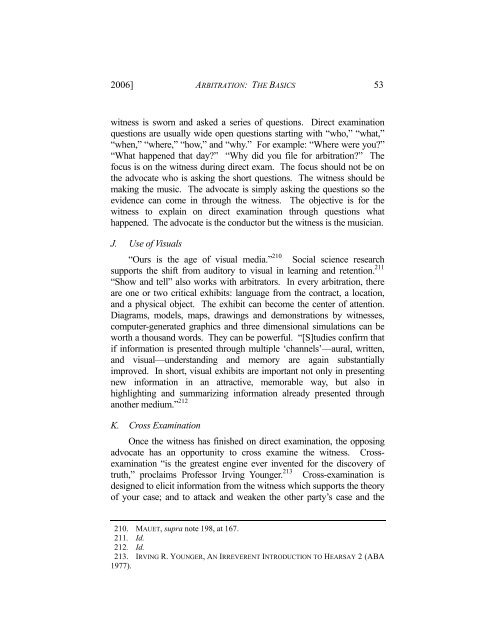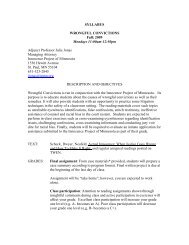2006/Vol. 5 No.1 - Hamline Law - Hamline University
2006/Vol. 5 No.1 - Hamline Law - Hamline University
2006/Vol. 5 No.1 - Hamline Law - Hamline University
Create successful ePaper yourself
Turn your PDF publications into a flip-book with our unique Google optimized e-Paper software.
<strong>2006</strong>] ARBITRATION: THE BASICS 53<br />
witness is sworn and asked a series of questions. Direct examination<br />
questions are usually wide open questions starting with “who,” “what,”<br />
“when,” “where,” “how,” and “why.” For example: “Where were you?”<br />
“What happened that day?” “Why did you file for arbitration?” The<br />
focus is on the witness during direct exam. The focus should not be on<br />
the advocate who is asking the short questions. The witness should be<br />
making the music. The advocate is simply asking the questions so the<br />
evidence can come in through the witness. The objective is for the<br />
witness to explain on direct examination through questions what<br />
happened. The advocate is the conductor but the witness is the musician.<br />
J. Use of Visuals<br />
“Ours is the age of visual media.” 210 Social science research<br />
supports the shift from auditory to visual in learning and retention. 211<br />
“Show and tell” also works with arbitrators. In every arbitration, there<br />
are one or two critical exhibits: language from the contract, a location,<br />
and a physical object. The exhibit can become the center of attention.<br />
Diagrams, models, maps, drawings and demonstrations by witnesses,<br />
computer-generated graphics and three dimensional simulations can be<br />
worth a thousand words. They can be powerful. “[S]tudies confirm that<br />
if information is presented through multiple ‘channels’—aural, written,<br />
and visual—understanding and memory are again substantially<br />
improved. In short, visual exhibits are important not only in presenting<br />
new information in an attractive, memorable way, but also in<br />
highlighting and summarizing information already presented through<br />
another medium.” 212<br />
K. Cross Examination<br />
Once the witness has finished on direct examination, the opposing<br />
advocate has an opportunity to cross examine the witness. Crossexamination<br />
“is the greatest engine ever invented for the discovery of<br />
truth,” proclaims Professor Irving Younger. 213 Cross-examination is<br />
designed to elicit information from the witness which supports the theory<br />
of your case; and to attack and weaken the other party’s case and the<br />
210. MAUET, supra note 198, at 167.<br />
211. Id.<br />
212. Id.<br />
213. IRVING R. YOUNGER, AN IRREVERENT INTRODUCTION TO HEARSAY 2 (ABA<br />
1977).
















